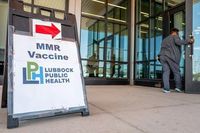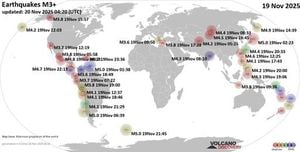As American families gear up for the new school year, a sobering reality is setting in: vaccine-preventable diseases like measles are making a comeback, fueled by declining childhood immunization rates and a growing number of exemptions. The United States is now facing its highest number of measles cases in over three decades, a trend mirrored in other parts of the world and raising alarms among health officials, parents, and policymakers alike.
According to data released by the Centers for Disease Control and Prevention (CDC), vaccination coverage among U.S. kindergartners for measles, mumps, and rubella (MMR), diphtheria, tetanus, and pertussis (DTaP), polio, and varicella all declined during the 2024-25 school year. MMR coverage, in particular, dropped to 92.5%—notably below the 95% threshold needed to prevent measles transmission within communities. Only 10 states managed to keep their MMR coverage above that critical level, with state rates ranging from a worrying 78.5% in Idaho to a reassuring 98.2% in Connecticut. The CDC’s findings are clear: “These immunization gaps have led to measles outbreaks in multiple states and the highest number of measles cases since the disease was declared eliminated in the U.S. in 2000.”
DTaP coverage also slipped, falling from 92.3% in the previous year to 92.1% in 2024-25, and polio vaccination rates followed suit, dropping slightly to 92.5%. The trend is unmistakable—fewer children are receiving critical vaccines, and the consequences are becoming increasingly visible. In Texas, for example, a deadly measles outbreak that began in late January 2025 finally ended in August after 762 confirmed cases, more than two-thirds of which were in children. The outbreak led to 99 hospitalizations and the tragic deaths of two children, according to the Texas Department of State Health Services. Gaines County, with some of the state’s lowest vaccination rates, reported the majority of cases—414 in total—while at least one case was logged in 37 counties. Unconnected cases cropped up in 13 other Texas counties, pushing the state’s total measles cases for 2025 above 800.
Experts are quick to point to the underlying cause: falling vaccination rates. Dr. Dale Bratzler, dean of the University of Oklahoma’s Hudson College of Public Health, told Nexstar, “Measles used to kill, you know, so many children, and we’re starting to see outbreaks again because parents are not getting their kids vaccinated.” Dr. William Moss of Johns Hopkins likened low-vaccination communities to “kindling for such outbreaks,” explaining, “If those sparks land in a community with low vaccine coverage, we’re going to see a larger measles outbreak. If it lands in a community with high vaccine coverage, we may only see one or a few cases.”
The CDC’s data shows that medical exemptions to vaccines have remained stable at 0.2%, but non-medical exemptions have reached an all-time high of 3.4%. In total, 3.6% of kindergartners—about 138,000 children—are now exempt from at least one vaccine. The disparity between states is stark: Idaho, which allows both personal and religious exemptions, has a non-medical exemption rate of 15%, while Connecticut, which eliminated religious exemptions in 2021, has a rate of just 0.1%. This policy difference is reflected in vaccination coverage, with higher exemption rates generally correlating to lower immunization rates.
“To reverse declining childhood immunization rates in the U.S., we need to focus on strengthening public trust in the safety and effectiveness of vaccines,” said Dr. William Moss, Executive Director of the International Vaccine Access Center (IVAC). “If more and more parents choose not to vaccinate their children for non-medical reasons, we will no doubt see a rise in disease outbreaks.”
The problem isn’t confined to the United States. Across the Atlantic, health leaders in southern England are also sounding the alarm. The BBC reports that a summer 2025 campaign is encouraging both children and adults to receive two doses of the MMR vaccine, following a rise in measles cases across the UK and Europe. In 2024, the UK recorded 2,911 laboratory-confirmed measles cases—the most in over a decade. In Hampshire and the Isle of Wight, there have been 29 confirmed cases between January 2024 and May 2025, though no full outbreak has yet occurred. First-dose MMR coverage in the region stands at 95%, but the second dose lags at 90%, with some areas like Southampton and Portsmouth dipping as low as 86-87%—all below the 95% herd immunity threshold.
Simon Bryant, director of public health at Hampshire County Council, expressed concern: “As people have been traveling over the summer and going back to school, the concern is that it may spread more. We have good uptake but it’s really important that is raised further so we have protection for the whole population and the vulnerable people in our society.”
The CDC, World Health Organization, and most infectious disease experts agree that the best way to prevent measles transmission is through two doses of the MMR vaccine. In the UK, children are advised to receive their first dose at one year old, with the second at 18 months. There are two types of MMR vaccines available—one containing porcine gelatine and one without—allowing families with specific dietary or religious preferences to make informed choices after consulting their GP.
The recent surge in measles cases has been so significant that some are calling 2025 “the year of measles in North America.” As reported by the Chicago Tribune, the U.S. per capita incidence of measles is now roughly 4 per 1 million people, and while cases have tailed off in the last two months, they remain higher than in 2019. Johns Hopkins University notes that the average county-level MMR vaccination rate dropped from 93.9% pre-pandemic to 91.3% post-pandemic, moving further away from the herd immunity threshold. The U.S. population has grown by 20% since 2000, but the number of unvaccinated individuals has outpaced this growth, increasing the pool of susceptible people.
Meanwhile, the national conversation around vaccines has become even more complicated. Health and Human Services Secretary Robert F. Kennedy Jr. has announced the winding down of the government’s mRNA vaccine development programs, canceling 22 projects with $500 million in funding. While the mRNA COVID-19 vaccine was credited with saving thousands of lives in the U.S. and millions worldwide, Kennedy’s decision to pivot away from this technology has sparked fierce debate. Critics argue that abandoning mRNA research could leave the country unprepared for future pandemics, as mRNA platforms allow for rapid vaccine development. Others hope that alternative vaccine technologies—such as inactivated, attenuated, or conjugate vaccines—will prove safer and more durable, though these approaches take time to develop and may not perform as well in real-world scenarios.
As the world waits to see what the next chapter holds, one thing is clear: even small declines in vaccination rates can have outsized consequences. The resurgence of measles serves as a stark reminder that public trust, sound policy, and scientific vigilance are all needed to keep vaccine-preventable diseases at bay. The stakes, as recent outbreaks have shown, are heartbreakingly high.





